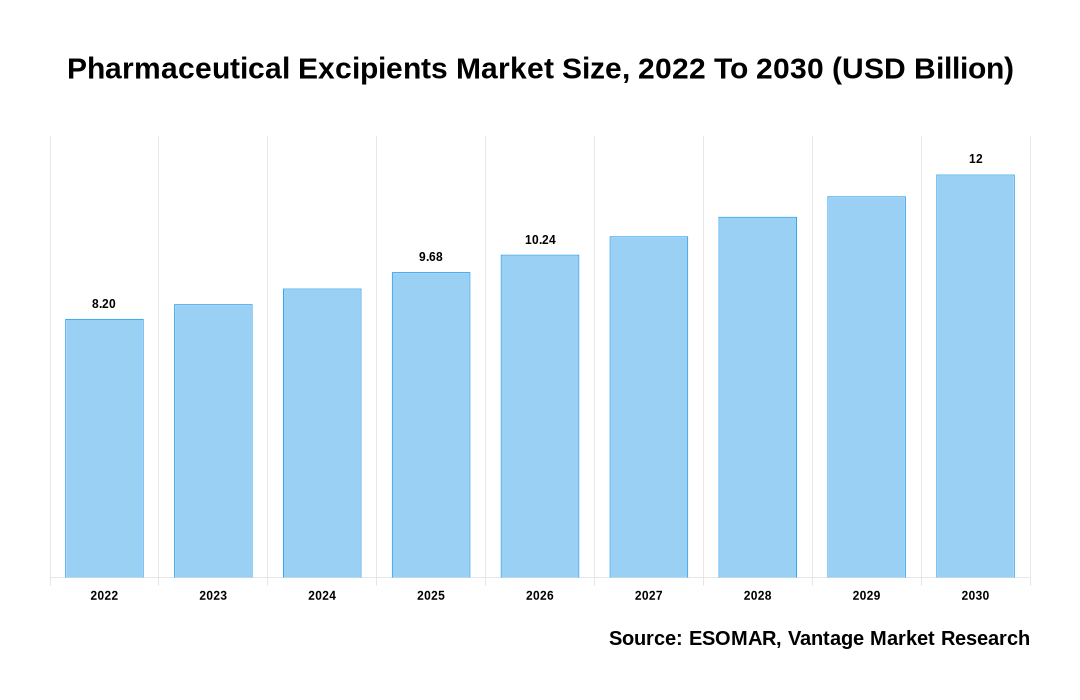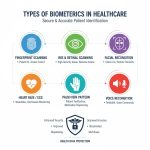Global Pharmaceutical Excipients Market
As stated in our extensive report, the Global Pharmaceutical Excipients Market accounted for USD 8.2 Billion in the year 2022 and is forecast to reach USD 12 Billion by 2030 at a CAGR of 5.7%.
Pharmaceutical Excipients promote the acceptability of the drug by the patient and increase the stability and bioavailability of the drug. In addition, Pharmaceutical Excipients help maintain the integrity of the drug, which contributes to the preservation of the drug. Various Pharmaceutical Excipients, including inorganic and organic chemicals, are based on their chemical nature. Organic chemicals, including carbohydrates, petrochemicals, petrochemicals, and proteins, can also act as binders, fillers, diluents, suspending or coating agents, flavoring agents, disintegrants, coloring agents, lubricants and lubricants, sweeteners, and preservatives, among others. The future of scientific and technological aids has changed and continues to change. Better progress has been made in harmonizing excipient pharmacopoeial monographs and applying new analytical methods to characterize excipients better.
Click To Get a Free Sample On the Research Study

The increased prevalence of chronic and lifestyle diseases worldwide, as well as significant investments made by the pharmaceutical industry in biologics development, are expected to have a considerable impact on the growth of the global Pharmaceutical Excipients market throughout the forecasted period. But during the projection period, the market expansion is expected to be slightly constrained by the expensive and time-consuming process of developing new medications. Furthermore, the widespread adoption of pharmaceutical production in numerous emerging countries is projected to create promising business growth opportunities over time.
Key Factors Influencing Pharmaceutical Excipients Market Growth
The growth of the global Pharmaceutical Excipients market can be attributable to the following:
- The significant factors influencing the growth of the Pharmaceutical Excipients market are increasing demand for functional excipients; recent patent expirations, increasing demand for Pharmaceutical Excipients; and the rapid development of nanotechnology.
- The growing pharmaceutical industry and increasing pharmaceutical production contribute significantly to the growth of the market.
The expansion of innovative treatments and the rising demand for oral pharmaceutical drugs due to the proliferation of pharmaceutical industries around the world propels the Pharmaceutical Excipients market.
- Nano-derived liposomes, nano-coated tablets, and vaccinations have all been created by combining the formulation of pharmaceuticals with nanotechnology in excipients.
- Additionally, product launches drive market growth. For example, in July 2021, DFE Pharma launched a new additive called Pharmacel MCC 90. It is microcrystalline cellulose (MCC) with silicon content.
Europe Region to Lead the Market
Europe Pharmaceutical Excipients market is getting more significant with maximum market share during the forecast period. Many well-known players in the Pharmaceutical Excipients business are based in this area. Europe holds the largest share of the Pharmaceutical Excipients market and is expected to follow a similar trend during the forecast period. Factors such as the rapidly growing pharmaceutical industry; increasing demand for functional excipients; prominent actors in the region; and technological advancement will significantly contribute to the market growth during the forecast period.
Conclusion
The overall Pharmaceutical Excipients market sales have been favorably impacted by growing demand for drug formulation, flavor, and identification, as Pharmaceutical Excipients have their uses in formulation, identification, and adding flavor to drugs.
The well-known players of the Global Pharmaceutical Excipients Market include Ashland Global Holdings (U.S.), BASF SE (Germany), DuPont (U.S.), Evonik Industries AG (Germany), Associated British Foods (UK), Archer Daniels Midland Company (U.S.), Lubrizol Corporation (U.S.) and others.
![[Market Research Reports] – Research Google News Blog | VMR.Biz](https://www.vmr.biz/wp-content/uploads/2022/12/logo-removebg-preview.png)











